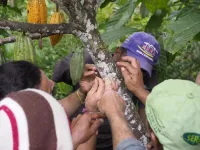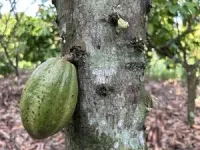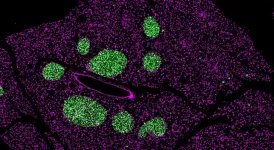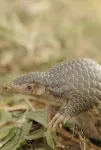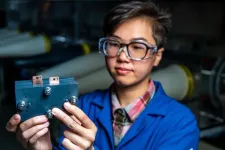(Press-News.org) Cocoa (Theobroma cacao L.) is a vital cash-crop for four to six million small-holder farmers across the tropics, and supports a global chocolate industry valued at over USD 100 billion annually. The combination of millions of farmers relying on cocoa for their livelihoods, and increasing global demand for the crop, has driven cocoa plantation expansion and intensification of farming practices, often at the expense of biodiversity and long-term sustainability.
A new research study led by the University of Oxford, in collaboration with Westlake University, China, Universidade Estadual de Santa Cruz, Brazil, and University of Göttingen, Germany, has highlighted the significant risks posed to cocoa production by climate change. However, the authors also identified farm management solutions that can both climate-proof cocoa crops and boost productivity without the need to expand plantations into forests.
The research, conducted across three major cocoa-producing countries—Brazil, Ghana, and Indonesia, which together account for 33% of global cocoa production—investigated key factors influencing cocoa yields. The findings revealed that increasing pollination rates above current levels could boost yields by 20%. This demonstrates that insufficient pollination is occurring to produce the maximum possible yield for many cocoa plantations. Separate to the impact of pollination, sites where temperatures were up to 7 degrees warmer had 20-31% lower cocoa yields, underscoring the vulnerability of cocoa-producing regions to the effects of climate change.
Co-author Dr Acheampong Atta-Boateng, who recently completed his doctoral work at the University of Oxford, said: ‘Cocoa is pollinated by tiny insects such as midges and thrips, and it comes as quite a surprise that most of the time there simply isn’t enough pollination happening to produce the cocoa crop that is possible.’
To support sustainable cocoa production, researchers recommend practical strategies to enhance pollination, such as maintaining leaf litter and other understory biomass, preserving soil organic matter, providing moderate shade, and reducing agricultural chemical use. These practices not only increase pollinator abundance, but also help regulate plantation temperatures and improve soil health, ensuring long-term plantation resilience.
Dr Tonya Lander, from the University of Oxford and first author of the study said: ‘This research shows that sustainable agricultural methods can significantly improve cocoa yields without farm expansion or intensification. By adopting biodiversity-centred, climate-resilient farming techniques, the cocoa sector can both increase production and safeguard farmers' livelihoods.’
Dr Tom Wanger of Westlake University, China added: ‘The rising demand for cocoa and the short-term economic benefits to farmers has led to plantation expansion and ecological homogenization at the expense of biodiversity and vital ecosystem services, like pollination. This study highlights the long-term risks of this approach, and how pollination can be a solution that works alongside climate-resilient agricultural systems to achieve long-term, ecologically and financially sustainable solutions.’
Notes to editors
Interviews with the corresponding author are available on request. Media contact: Thomas Wanger, tomcwanger@gmail.com or Tonya Lander, tonya.lander@chch.ox.ac.uk
The paper ‘Global chocolate supply is limited by low pollination and high temperatures’ will be published in Nature Portfolio, Communications Earth & Environment at 10 am GMT / 5 am ET Friday 14 February 2025 at: https://www.nature.com/articles/s43247-025-02072-z
To view a copy of the paper before this under embargo contact Thomas Wanger, tomcwanger@gmail.com or Tonya Lander, tonya.lander@chch.ox.ac.uk
Additional details
Images and videos related to the study are available at https://drive.google.com/drive/folders/1xBJazPOUkKxZ5BcbLc3jnBndAJ1cmFv7?usp=sharing. These are for editorial purposes only and MUST be credited (see caption file in folder). They must NOT be sold on to third parties.
About the University of Oxford
Oxford University has been placed number 1 in the Times Higher Education World University Rankings for the ninth year running, and number 3 in the QS World Rankings 2024. At the heart of this success are the twin-pillars of our ground-breaking research and innovation and our distinctive educational offer.
Oxford is world-famous for research and teaching excellence and home to some of the most talented people from across the globe. Our work helps the lives of millions, solving real-world problems through a huge network of partnerships and collaborations. The breadth and interdisciplinary nature of our research alongside our personalised approach to teaching sparks imaginative and inventive insights and solutions.
Through its research commercialisation arm, Oxford University Innovation, Oxford is the highest university patent filer in the UK and is ranked first in the UK for university spinouts, having created more than 300 new companies since 1988. Over a third of these companies have been created in the past five years. The university is a catalyst for prosperity in Oxfordshire and the United Kingdom, contributing £15.7 billion to the UK economy in 2018/19, and supports more than 28,000 full time jobs.
The Department of Biology is a University of Oxford department within the Maths, Physical, and Life Sciences Division. It utilises academic strength in a broad range of bioscience disciplines to tackle global challenges such as food security, biodiversity loss, climate change and global pandemics. It also helps to train and equip the biologists of the future through holistic undergraduate and graduate courses. For more information visit www.biology.ox.ac.uk.
About Westlake University, China
Westlake University was inaugurated in 2018 as the first private university in China. Westlake University has four schools, School of Science, School of Engineering, School of Life Sciences and the School of Medicine to contribute to research and teaching with almost 2,000 employees and 2,200 doctoral students. The Sustainable Agricultural Systems & Engineering lab conducts data-driven work on the benefits of diversified agricultural systems, develops environmental monitoring technology, and translates results into effective policy recommendations
About the Universidade Estadual de Santa Cruz, Brazil
Located in Ilhéus, Bahia, Brazil, the Universidade Estadual de Santa Cruz (UESC) stands at the heart of the country’s historic cocoa-producing region. With approximately 8,000 students enrolled across 35 undergraduate and 27 graduate programs, UESC is a leading institution in research and education. One of its greatest strengths is the study of the Atlantic Forest, a globally recognized biodiversity hotspot. A key focus of this research is the role of cabrucas—a traditional cocoa agroforestry system where cacao is cultivated under the shade of old-growth Atlantic Forest trees. This sustainable practice plays a crucial role in preserving the extraordinary plant and animal diversity of southern Bahia, reinforcing UESC’s commitment to environmental conservation and sustainable development.
About the University of Göttingen, Germany
The University of Göttingen is an internationally renowned research university. Founded in 1737 in the Age of Enlightenment, the University is committed to the values of social responsibility of science, democracy, tolerance and justice. It offers a comprehensive range of subjects across 13 faculties: in the natural sciences, humanities, social sciences and medicine. With about 28,000 students and more than 210 degree programmes, the University is one of the largest in Germany. Research of the Functional Agrobiodiversity and Agroecology group focuses on socio-economically relevant topics in agroecology, such as the loss of biodiversity and associated ecosystem services by the intensification and expansion of agriculture and climate change in temperate and tropical regions.
END
Climate change threatens global cocoa production: New study highlights pollination-based solutions
2025-02-14
ELSE PRESS RELEASES FROM THIS DATE:
Mouse study finds impaired cell development: Intermittent fasting could be unsafe for teenagers
2025-02-14
A recent study reveals that age plays a significant role in the outcomes of intermittent fasting. Researchers from Technical University of Munich (TUM), LMU Hospital Munich, and Helmholtz Munich discovered that chronic intermittent fasting disrupted the development of insulin-producing beta cells in young mice. The findings raise concerns about potential risks for humans, especially teenagers.
“Intermittent fasting is known to have benefits, including boosting metabolism and helping with ...
From collisions to stellar cannibalism – the surprising diversity of exploding white dwarfs
2025-02-14
Astrophysicists have unearthed a surprising diversity in the ways in which white dwarf stars explode in deep space after assessing almost 4,000 such events captured in detail by a next-gen astronomical sky survey. Their findings may help us more accurately measure distances in the Universe and further our knowledge of “dark energy”.
The dramatic explosions of white dwarf stars at the ends of their lives have for decades played a pivotal role in the study of dark energy – the mysterious force responsible for the accelerating expansion of the Universe. They also provide the origin of many elements in our ...
World Pangolin Day celebrated with new genomes to aid the world’s most trafficked animal
2025-02-14
Pangolins are unique as they are the only mammal to be covered in scales. Even though they are scaly, photos of them are typically met with “awwws” from the viewers who find them adorable. Importantly, though, pangolins play an essential role in maintaining their ecosystem. Their other “unique trait” is that they are the most trafficked wild animal in the world, with more than 900,000 poached in the past two decades. Much of this is due to their high value for use in traditional medicine that ...
Dangerous bacteria lurk in hospital sink drains, despite rigorous cleaning
2025-02-14
We hope to be cured when we stay in hospital. But too often, we acquire new infections there. Such ‘healthcare-associated infections’ (HAI) are a growing problem worldwide, taking up an estimated 6% of global hospital budgets. In the EU alone, HAIs add up to more than 3.5 million cases per year, resulting in 2.5 million disability-adjusted life years, a cost of up to €24 billion, and 90,000 deaths. They are likewise the sixth leading cause of death in the US.
Patients with lowered immune defenses, and in some hospitals, ...
Mini flow battery speeds energy storage research
2025-02-14
RICHLAND, Wash.—Sometimes, in order to go big, you first have to go small. That’s what researchers at the Department of Energy’s Pacific Northwest National Laboratory have done with their latest innovation in energy storage.
With a goal to speed the time to discovery of new grid energy storage technology, the team designed a compact, high-efficiency flow battery test system that requires an order of magnitude less starting material while delivering results equal to the standard lab-scale ...
Graphite production gets a makeover
2025-02-14
Collaboration efforts between the Texas A&M University Artie McFerrin Department of Chemical Engineering and the U.S. Department of Energy Advanced Research Projects Agency-Energy (ARPA-E) have led to innovative research on how petroleum coke is processed.
This almost $3 million three-year research project will convert petroleum coke to graphite for energy storage. The newer process uses a lower temperature and shorter time to produce graphite from petroleum coke.
This new catalytic graphitization technology will ...
Ancient Egyptian mummified bodies smell ‘woody,’ ‘spicy’ and ‘sweet’
2025-02-14
UCL Press Release
Under embargo until Friday 14 February 2025, 00:01 UK time / 19:01 Thursday 13 February US Eastern time
Ancient Egyptian mummified bodies smell ‘woody,’ ‘spicy’ and ‘sweet’, finds a new study led by researchers from UCL and the University of Ljubljana, revealing new details about mumification practices.
The research, published in Journal of the American Chemical Society, is the first time that the smells of mummified bodies have been systematically studied combining a mix of instrumental and sensory techniques, including an electronic ‘nose’ ...
MIT engineers develop a fully 3D-printed electrospray engine
2025-02-13
CAMBRIDGE, MA – An electrospray engine applies an electric field to a conductive liquid, generating a high-speed jet of tiny droplets that can propel a spacecraft. These miniature engines are ideal for small satellites called CubeSats that are often used in academic research.
Since electrospray engines utilize propellant more efficiently than the powerful, chemical rockets used on the launchpad, they are better suited for precise, in-orbit maneuvers. The thrust generated by an electrospray emitter is tiny, so electrospray engines typically use an array of emitters that are uniformly ...
Speculum exams unnecessary for HPV screening
2025-02-13
Genital human papillomavirus is the most common sexually transmitted infection in the United States and is thought to be responsible for more than 99% of cervical cancers.
HPV screening usually entails a speculum-based exam, which is an uncomfortable experience for most patients, especially those who have physical disabilities.
In two studies, published in Preventive Medicine Reports and JAMA Network Open, University of Michigan researchers are the first to demonstrate in the U.S. that self-sampling is just as effective as speculum-based testing for HPV detection.
Most people who have HPV are usually unaware that they have it.
By ...
Reduced prediabetes in people who ate broccoli compound
2025-02-13
The chemical compound sulforaphane found in broccoli sprouts can be linked to improved blood sugar levels in prediabetes, a precursor to type 2 diabetes. This has been shown in a study conducted at the University of Gothenburg. The broccoli compound had a more significant effect on blood sugar levels in certain people.
Researchers at the University of Gothenburg have previously identified sulforaphane as an antidiabetic agent in type 2 diabetes. A patient study conducted in 2017 demonstrated significantly lower blood sugar in people with diabetes after they took large ...
